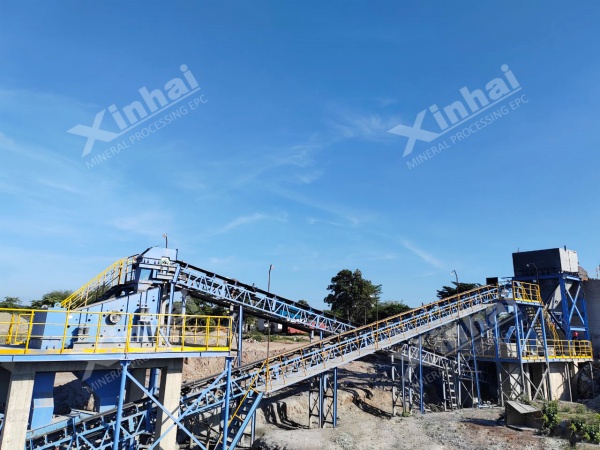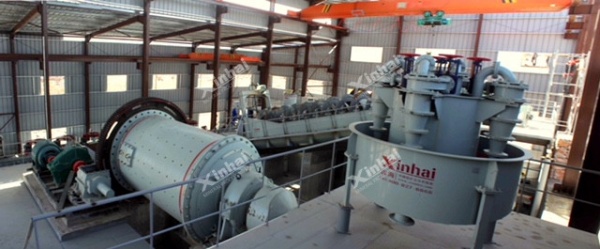If you want to know more information (such as product/process price, etc.), please contact us 24-hour telephone
Mica plays a pivotal role in modern industry. It is an essential resource in insulation materials, high-end coatings, electronic components, high-temperature-resistant materials, and more. However, these high-performance applications impose stringent requirements on raw mica, particularly in terms of purity, particle size, color, and impurity content. Meeting these requirements depends on professional, efficient, and advanced mining and beneficiation technologies.
As a professional mineral processing service provider and equipment manufacturer, Xinhai Mining offers a complete range of services—from mining and process design to beneficiation plant construction, management, and operation. This article provides an in-depth look at the complete mica beneficiation process—from raw ore to final concentrate.

There are two primary methods for mining mica: open-pit mining and underground mining. The selection of a mining method depends on the occurrence characteristics of the ore body, including burial depth, thickness, dip angle, morphology, grade distribution, and host rock stability. Additionally, both technical and economic feasibility must be considered.
(1) Open-pit mining – Suitable for shallowly buried ore bodies with thin overburden.
The main steps involved in open-pit mining are:
Overburden removal: Removing the overlying rock, soil, and vegetation covering the ore body using heavy equipment such as bulldozers, scrapers, draglines, and hydraulic excavators. Stripping is usually carried out in layers.
Drilling and blasting: Drilling holes in the exposed ore body and loading them with explosives for blasting. Rotary drills or down-the-hole drills are commonly used.
Ore loading and transportation: Loading the blasted ore onto transport vehicles and hauling it to the crushing station or ore stockpile.
(2) Underground mining – Suitable for deep-seated ore bodies.
The key steps include:
Development: Establishing access to the ore body through shafts, declines, or adits, including vertical (shaft), horizontal, inclined, or combined development systems.
Ore access and preparation: Excavating drifts and crosscuts near or within the ore body.
Cutting: Creating cut slots or drawpoints in the ore blocks.
Stoping: The room-and-pillar method is commonly used for mica ore extraction.

Xinhai Mining adopts modern and efficient mining equipment to ensure both production capacity and operational safety. In mining process design, we fully consider aspects such as site reclamation, water resource management, and dust control.
In addition, preliminary ore sorting is performed during the mining stage to remove large pieces of waste rock, thereby increasing the grade of the run-of-mine ore and improving downstream processing efficiency.
After mining, mica ore must undergo further processing to remove gangue minerals such as quartz, feldspar, and iron in order to improve its grade and purity. Additionally, it must be classified according to particle size or flake thickness to meet the specific requirements of various industries.
The raw ore is first crushed using jaw crushers and cone crushers, then ground in a ball mill to achieve the desired particle size. Precise particle size control is a key factor influencing the effectiveness of subsequent separation processes.
Mica flakes are separated from gangue minerals based on particle size. Common classification methods include:
Air (wind) classification: Utilizing airflow and vibration screening principles. Due to their low density and plate-like structure, mica flakes are easily carried by air, whereas the denser gangue particles settle as tailings.
Hydrocyclone classification: Provides hydraulic classification and assists in size separation. Xinhai's hydrocyclones are known for their simple structure, large capacity, and effective classification, making them ideal for mica processing.

In some cases, gangue minerals are similar to mica in physical or chemical properties, making them difficult to separate by size alone. Flotation is then employed.
The principle involves using collectors, frothers, and regulators to selectively separate mica from quartz or feldspar.
Mica ores are often associated with iron-bearing minerals, and additional ferromagnetic impurities may be introduced during the crushing and grinding stages.
Magnetic separation effectively removes these iron impurities. Commonly used equipment includes magnetic drums, wet magnetic separators, and high-gradient magnetic separators.

After separation, the mica concentrate still contains a high moisture content. Thickeners and vacuum filters are used for dewatering, followed by rotary kilns or dryers for final drying to achieve the required product moisture level.
Process expertise: Xinhai customizes beneficiation flowsheets based on ore characteristics. A typical combination might include efficient air classification, refined flotation, and intense magnetic separation.
Advanced equipment: Core equipment is manufactured with cutting-edge technology, ensuring high efficiency, energy savings, and superior separation performance.
Tailored solutions: Products can be customized based on clients’ specific requirements for particle size distribution, color (whiteness), purity, and mica type.
Environmental responsibility: Xinhai provides complete solutions for wastewater treatment, dust control, and tailings management, ensuring environmentally sustainable operations.

Conclusion
This article introduced the key methods of mica mining and beneficiation, including the detailed processing flow. With over 30 years of industry experience, Xinhai Mining is dedicated to providing one-stop mineral processing services (EPCM+O) to clients worldwide. Having served over 2,000 mines globally, Xinhai has earned a strong reputation for professionalism and reliability.
If you are planning a mica mining or processing project, we welcome you to contact us for customized technical support and equipment solutions.